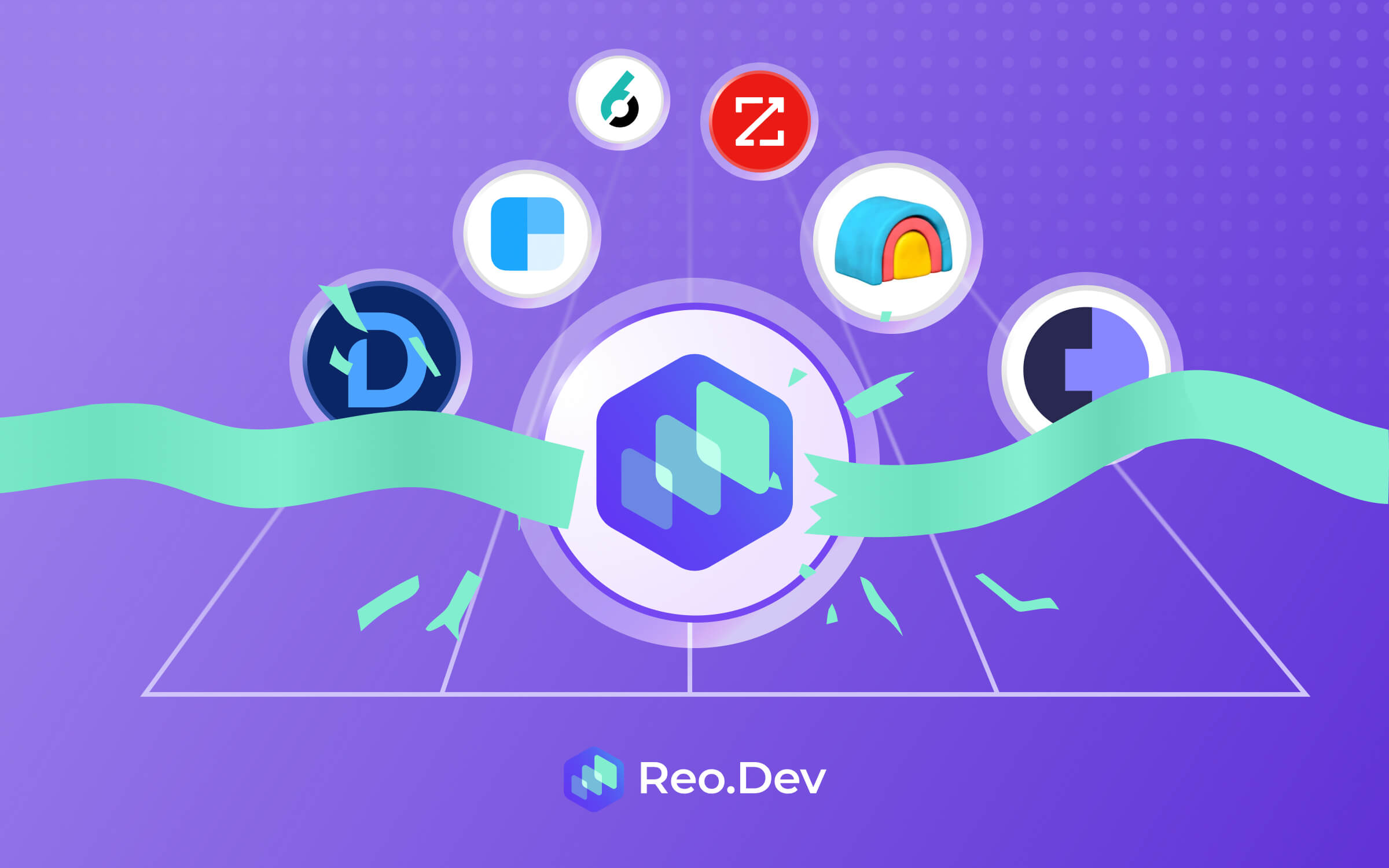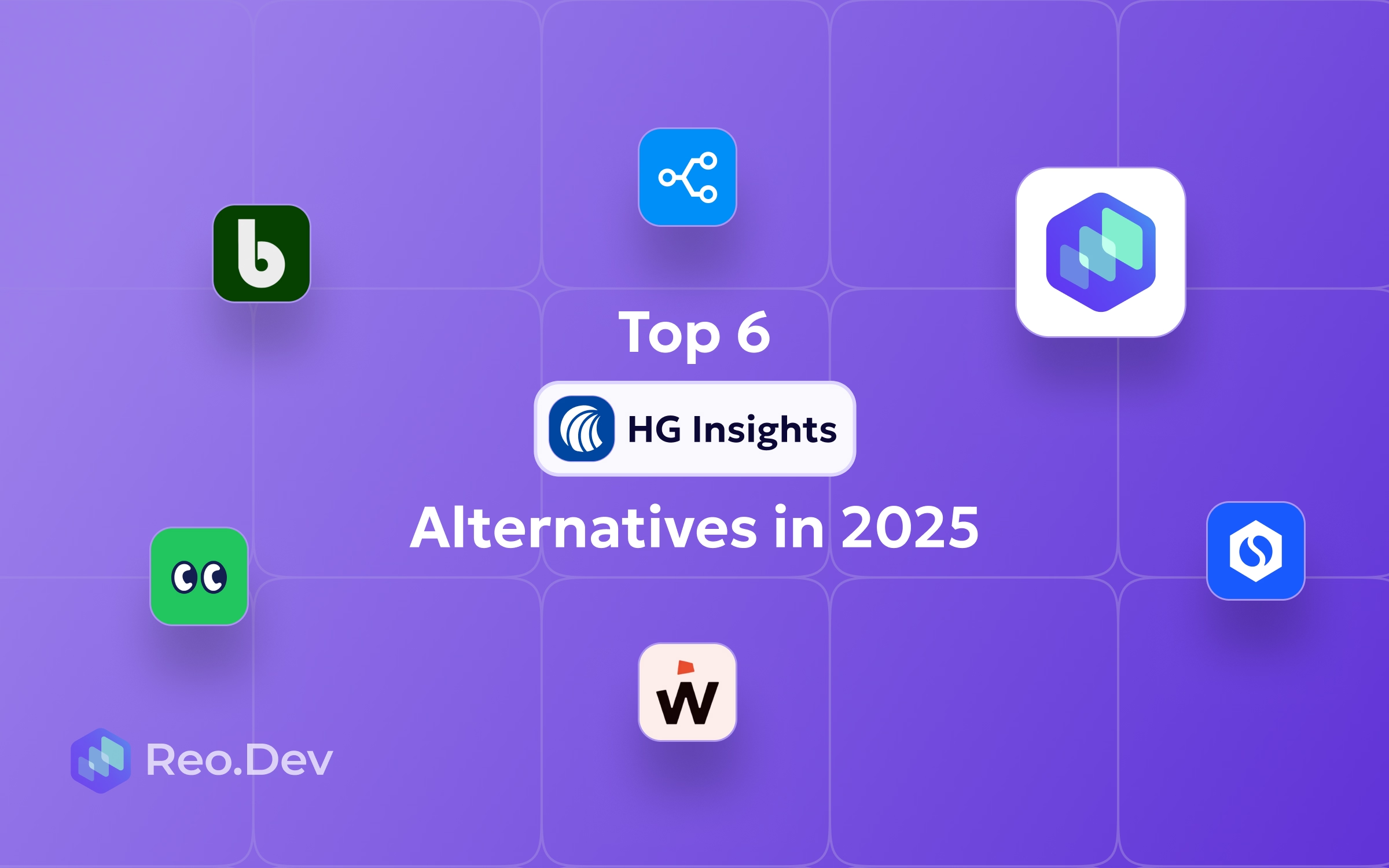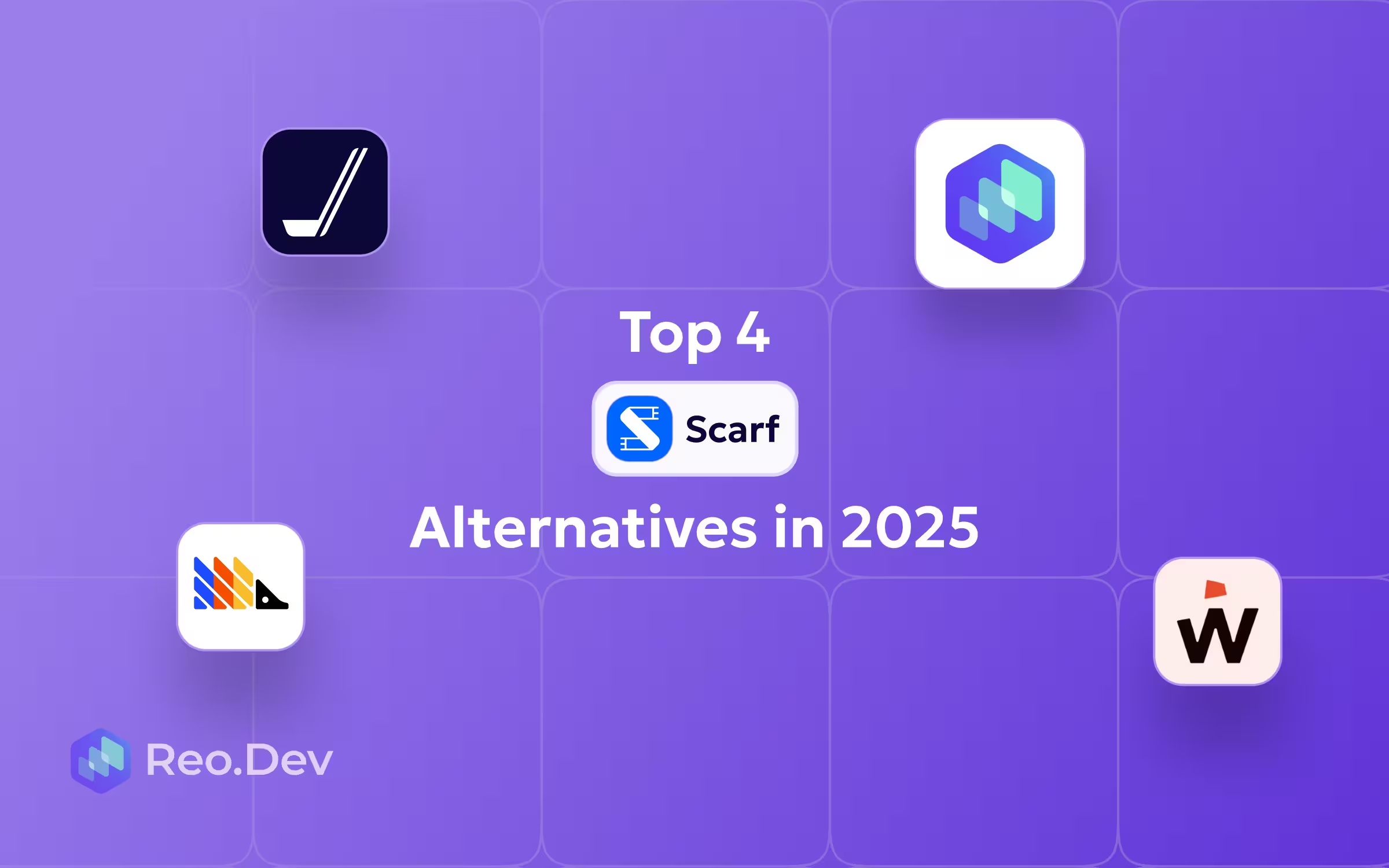Koala is a great starting point for early-stage DevTool teams exploring intent-based GTM. But if you're scaling, selling open source, or care about deep product usage signals - you’ll quickly hit its limits.
If you're scaling your DevTool GTM motion, here are five key capabilities you should look for in a Koala alternative:
- Custom Product Usage Signals: Koala tracks GitHub activity, but misses deeper in-product signals like SDK imports, API calls, and CLI usage-key indicators of true activation.
- OSS Install Attribution: If you're open source, you’ll need visibility into installs via Docker, npm, pip, etc.-something Koala doesn’t natively support.
- Flexible Scoring Models: Koala uses fixed scoring. Modern GTM teams need custom funnel stages and signal weights tailored to their journey.
- Champion-Level Insight: Koala doesn’t identify who’s behind the activity. For land-and-expand, you need enriched profiles, titles, and org mapping.
- Actionable GTM Playbooks: Basic alerts aren’t enough. The right tool should translate intent signals into clear, targeted sales plays.
Best Koala Alternatives
Reo.dev
Pros
Reo.dev is a developer-native intent platform purpose-built for DevTool and OSS companies. It offers comprehensive visibility across GitHub, your product, package managers, forums, and documentation-bringing depth and context to every signal. Key advantages include:
- Full-Stack Developer Signals:
- GitHub Activity: Track high-intent signals like stars, forks, pull requests, issues, and comments across all your open-source repos to identify early developer interest and engagement trends.
- OSS Install Attribution: Get install-level visibility from 40+ package managers (like npm, Docker, PyPI, Maven), allowing you to surface which companies are running your open-source product in production or evaluation environments.
- Product Usage Telemetry: Ingest key SDK, API, CLI, or in-app usage metrics via Reo.dev’s API - then map them to organizations using developer login data, IPs, and custom enrichment logic. This helps uncover deep product engagement beyond the surface.
- Documentation & Code Interactions: See which code blocks are being copied, and who’s engaging with high-intent docs.
- Forum & Community Engagement: Monitor mentions and discussions across third-party platforms like Reddit, Hacker News, Dev.to, Stack Exchange, Product Hunt, and Slack - so you don’t miss when devs are talking about (or troubleshooting) your product.
- Anonymous Web Traffic: Identify unknown developers visiting your site by stitching together GitHub activity, product usage, and install data - turning anonymous signals into actionable account-level insights.
- Custom Scoring That Matches Your Funnel: Lets teams assign custom scores (on a scale of 0-10) to certain activity types like Documentation, GitHub, product, website, form interactions, code interactions, and communities.Its AI engine then calculates Developer Activity and Account Activity scores based on your GTM motion - helping you prioritize the right leads with context, not guesswork.
Bonus: You can flag incorrect data at the account level to keep your intelligence clean and actionable - something many tools still miss.
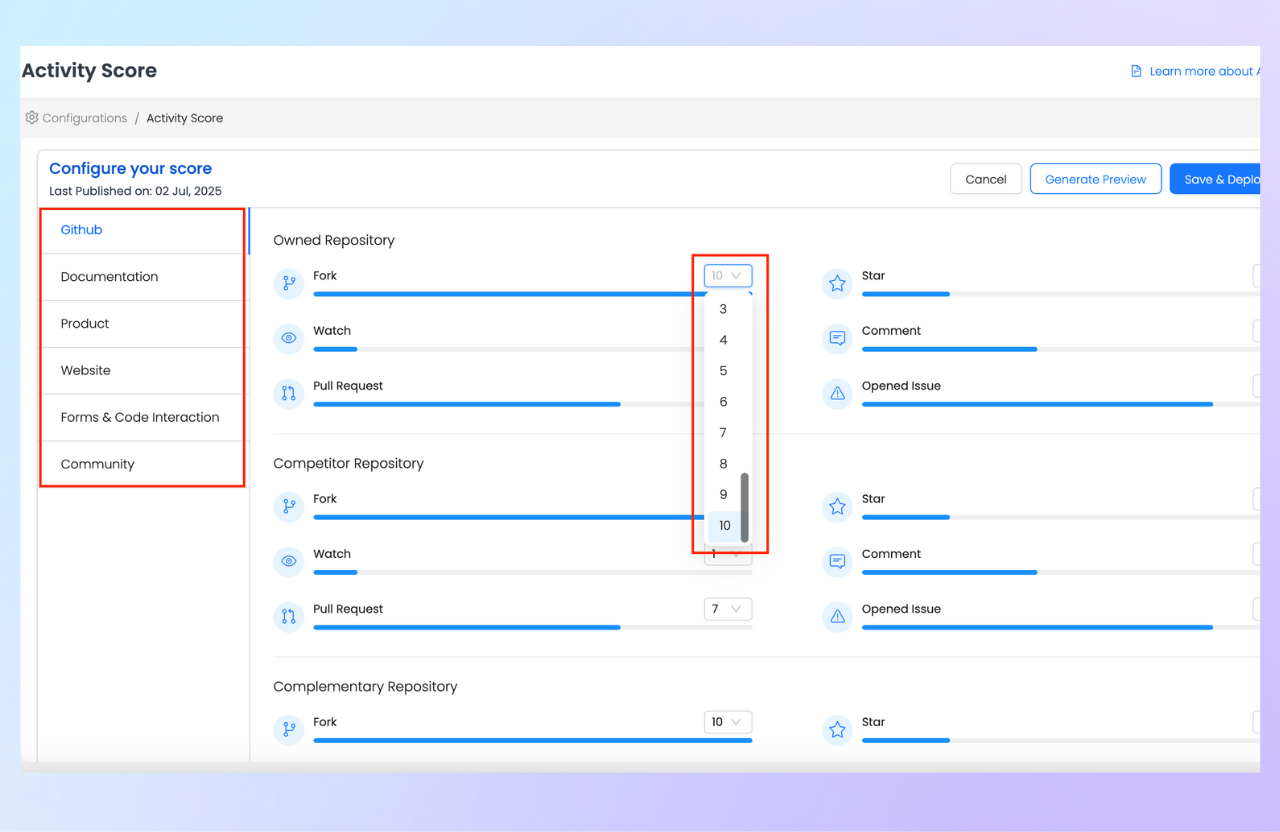
- Enriched Developer Profiles: Converts anonymous GitHub handles and IPs into detailed profiles with org, title, and behavior data - helping sales and DevRel teams identify champions and power users early.
- Built-In Dev GTM Playbooks: Comes with GTM playbooks optimized for PLG, OSS, and community-led strategies - pre-configured with segment logic and campaign flows.
Cons
- Reo.dev has a slight learning curve - initial setup typically requires collaboration with their team to fully customize signals and scoring.
Best Use Case
Reo.dev is ideal for DevTool and OSS companies that want deep developer intent data, flexible scoring, and activation workflows grounded in real product usage.
{{product-blog-banner}}
Zoominfo
Pros
Zoominfo is one of the most comprehensive B2B data platforms, known for its massive database of company and contact information. It offers:
- Third-Party Intent Signals at Scale: Zoominfo tracks topic-based buying intent using data from news sites, forums, and review platforms. Signals are sourced from a network of 210M IP-to-org pairings and 6T+ monthly keyword-device interactions.
- Prebuilt GTM Plays: Users can access a library of GTM plays filtered by channel and sales stage to guide outreach and pipeline acceleration.
- Deep Firmographic & Contact Intelligence: Zoominfo’s core strength lies in enriched contact profiles via CRM integrations and SDK/API support, making it a powerful enrichment layer for B2B sales teams.
Cons
- No OSS Install Attribution: Zoominfo doesn’t support install-level tracking from package managers like npm or Docker - a major gap for open-source DevTool companies.
- Lack of Product Usage Telemetry: There’s no support for first-party in-product signals (like SDK imports or API usage), limiting its value for product-led GTM teams.
- Fixed Scoring Logic: Zoominfo doesn’t allow custom signal scoring or funnel modeling, which can make it hard to qualify technical leads accurately.
Best Use Case
Zoominfo is a great fit for traditional B2B teams looking for reliable firmographic data and broad-market contact enrichment. If you’re focused on DevTool GTM, OSS, or product usage signals - you’ll likely need to pair it with a more developer-native intent platform.
Demandbase
Pros
Demandbase is a powerful platform for Account-Based Marketing (ABM) at scale, offering rich contact intelligence and multi-source intent data. Key strengths include:
- Buying Group Intelligence: Get dynamic contact recommendations based on recency, title, data coverage, and popularity - across a database of 150M+ B2B contacts and 99M+ companies.
- Full-Funnel GTM Playbooks: Unlike most platforms that focus on SDRs, Demandbase offers playbooks for Sales, Marketing, and RevOps teams across the entire buyer journey.
- Intent Partnerships for Deeper Signal Coverage: Demandbase integrates third-party data sources like Bombora (surge intent), G2 (bottom-of-funnel buyers), and TrustRadius (in-market activity), layering them with technographics, firmographics, and company news.
Cons
- No OSS Install Attribution: There’s no visibility into package manager usage (npm, Docker, pip) - which is critical for open-source DevTool adoption.
- No Product Usage Telemetry: Demandbase doesn’t support in-app behavior or SDK/API signal tracking, which limits product-led GTM applicability.
- Lack of Custom Scoring: Users cannot define or adjust signal weights or funnel stages, making it harder to prioritize developer accounts with nuanced engagement patterns.
Best Use Case
Demandbase is typically known for its strong ABM campaigns, so it’s an ideal fit for large enterprises who want to execute ABM campaigns across multiple touchpoints (email and ads).
6Sense
Pros
6Sense is a robust intent data platform built for enterprise-grade Account-Based Marketing (ABM) and personalization. Its core strengths include:
- Multi-Layered Intent Signals: Tracks both first-party (content consumption, page visits) and third-party (keyword searches, firmographics, technographics) signals to surface in-market accounts.
- Custom Enrichment Workflows: Offers a visual builder for defining rules around lead enrichment, helping mitigate issues with outdated or incomplete contact data.
- AI-Powered Outreach: 6Sense’s AI Writer enables sales teams to craft personalized messaging based on real-time account activity and buying intent patterns.
Cons
- No OSS or Product Usage Signals: 6Sense doesn’t support telemetry from GitHub, SDK/API, or package managers - making it less effective for DevTool teams.
- No Dev-Specific Funnel Modeling: There's no flexibility to define custom funnel stages or score developer behavior natively.
- No Built-In Sales Playbooks: Unlike competitors, 6Sense doesn’t offer a library of GTM plays tailored for different personas or sales stages.
Best Use Case
6Sense is best suited for large ABM teams seeking advanced segmentation, orchestration, and omnichannel personalization. Dev-first companies looking for developer behavior tracking and OSS adoption signals should explore more DevGTM focused tools.
Clay
Pros
Clay offers a flexible, AI-powered prospecting platform that helps teams identify and prioritize leads across a wide range of signals. Key advantages include:
- Advanced Filtering & Signal Enrichment: Clay allows users to build custom lead scoring models using filters like job changes, event attendance, news mentions, social activity, and support tickets - all enriched in real-time.
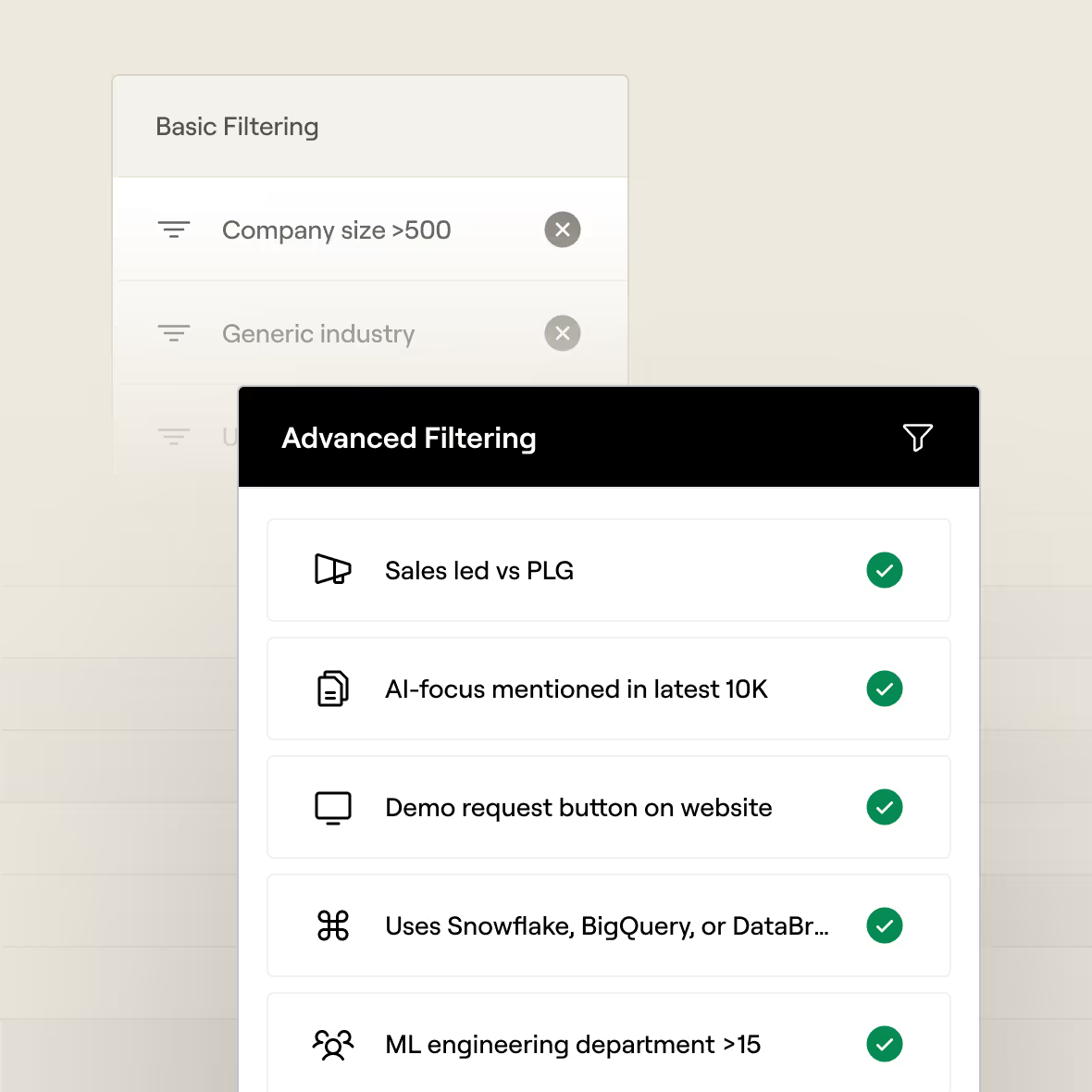
- Multi-Team Playbook Support: Through its built-in playbook library (Claybooks), teams across Sales, Marketing, CS, and HR can quickly spin up workflows that accelerate pipeline and outreach personalization.
- Visual Interface for Dynamic Workflows: Clay’s spreadsheet-style UI makes it easy to combine enrichment, filtering, and AI workflows in a no-code environment - making prospecting both powerful and scalable.
Cons
- No Product Usage Signals: Clay doesn’t track in-product behavior (like SDK imports, CLI usage, or project creation), making it less relevant for DevTool teams relying on product-led growth.
- Lacks OSS Telemetry: There’s no attribution for package manager installs or developer activity on GitHub, which limits visibility into open-source adoption.
- Steep Learning Curve: According to G2 reviews, Clay’s interface and automation logic can take time to master, especially for first-time users.
Best Use Case
Clay is a great choice for mid-market sales and marketing teams looking to enrich lead data and trigger outreach based on non-product signals. For Dev-first companies tracking in-app or OSS usage, pairing Clay with a developer-intent platform like Reo.dev is recommended.
Clearbit (now part of HubSpot's Breeze Intelligence Suite)
Pros
Clearbit is a widely adopted enrichment and intent platform that integrates seamlessly into existing GTM workflows. Its key strengths include:
- Website Behavior as Intent Signals: Clearbit captures first-party signals like visits to product, pricing, and solutions pages - helping teams prioritize accounts showing buying interest.
- Smart Lead Scoring & Segmentation: Users can build scoring models based on deal stage, lifecycle, and website interactions - and segment leads into automated workflows for targeted outreach.
- Educational Resources: Clearbit offers practical guides (“Clearbit Books”) for teams looking to level up their GTM strategy and campaign execution.
Cons
- No OSS Attribution or Product Usage Signals: Clearbit doesn’t track install-level events from GitHub or package managers, nor does it capture in-app behavior like SDK usage or API calls - limiting its utility for DevTool and PLG teams.
- Rigid Data Model: There’s no support for customizing signal weights or funnel stages, making it difficult to tailor scoring logic to your product journey.
- Usage-Based Pricing Complexity: Several G2 reviews mention confusion around Clearbit’s credit-based billing model, especially at scale.
Best Use Case
Clearbit is best suited for marketing and RevOps teams looking for seamless lead enrichment and website-based intent tracking. For companies needing deeper developer behavior insights or OSS telemetry, Reo.dev or Scarf are better aligned.
Cognism
Pros
Cognism is a privacy-first data provider with strong compliance coverage and global reach. Key strengths include:
- Global Intent Signals: Tracks signals like mergers & acquisitions, funding alerts, job changes, technographics, and hiring trends - useful for identifying in-market accounts at scale.
- Multi-Channel GTM Playbooks: Offers tailored outreach plays for AEs, SDRs, and marketing teams across email, events, and LinkedIn.
- Privacy & Compliance Leadership: Cognism is fully GDPR and CCPA compliant, with data filtered against Do Not Call (DNC) lists - making it a top choice for companies operating in regulated regions.
Cons
- No Product Usage or OSS Signals: Cognism doesn’t support telemetry from SDKs, APIs, or package managers - limiting its value for DevTool teams and PLG motions.
- No Custom Signal Scoring: You can’t define custom funnel stages or assign weights to different signals - a key gap for teams running precision GTM.
Best Use Case
Cognism is ideal for GDPR-compliant companies looking for reliable contact data and broad-market intent signals. For DevTool teams seeking developer telemetry or OSS adoption insights, more developer-native platforms like Reo.dev may be a better fit.
Pocus
Pros
Pocus is purpose-built for product-led growth (PLG), making it a strong choice for SaaS and DevTool teams focused on usage-based GTM. Key features include:
- Granular Product Usage Tracking: Captures signals like feature adoption, seat expansion, and usage depth-helping sales teams prioritize accounts based on real product behavior.
- Custom Funnel & Scoring Logic: Teams can define usage-based funnels and tailor scoring rules to match their GTM motion, making it easier to surface product-qualified leads (PQLs).
- Playbooks for GTM & Success Teams: Offers a built-in library of outbound, inbound, and customer success playbooks to operationalize PLG across the funnel.
Cons
No OSS Attribution: Pocus doesn’t track open-source signals like GitHub activity or install telemetry from npm, Docker, or pip-making it less useful for OSS-led companies.
- Steep Learning Curve: G2 reviewers frequently mention that setup and onboarding can be complex, especially for non-technical users.
Best Use Case
Pocus is best suited for PLG SaaS teams looking to operationalize product signals in sales and success workflows. If OSS visibility or GitHub-based signals are critical, consider pairing it with a more developer-native tool like Reo.dev.
Scarf
Pros
Scarf is one of the few platforms purpose-built for open-source adoption tracking. It excels at surfacing install-level intent from developer activity. Key strengths include:
- OSS Install Attribution: Tracks installs and usage across major package managers including npm, Docker, PyPI, and direct Git clone events-helping teams spot when a developer or company begins using their OSS tool.
- Playbooks for OSS GTM: Offers a dedicated playbook library focused on identifying and converting open-source qualified leads, streamlining the OSS-to-paid journey.
- Org-Level Usage Volume: Aggregates telemetry data by organization, making it easier to prioritize accounts showing steady OSS adoption growth.
Cons
- Limited Activation Signals: Scarf focuses on install and runtime events but doesn’t track GitHub engagement (stars, forks, PRs) or developer behavior inside documentation or the product.
- No Custom Scoring or Funnel Modeling: Users can’t define funnel stages or score intent signals across a broader GTM journey.
- Lacks Broader Contextual Signals: Scarf does not include firmographic, social, or web activity data-limiting its value for holistic developer intent.
Best Use Case
Scarf is a solid choice for OSS-first companies looking to track install-based adoption at the organization level. For deeper developer insights and full-funnel engagement tracking, tools like Reo.dev may offer broader signal coverage.
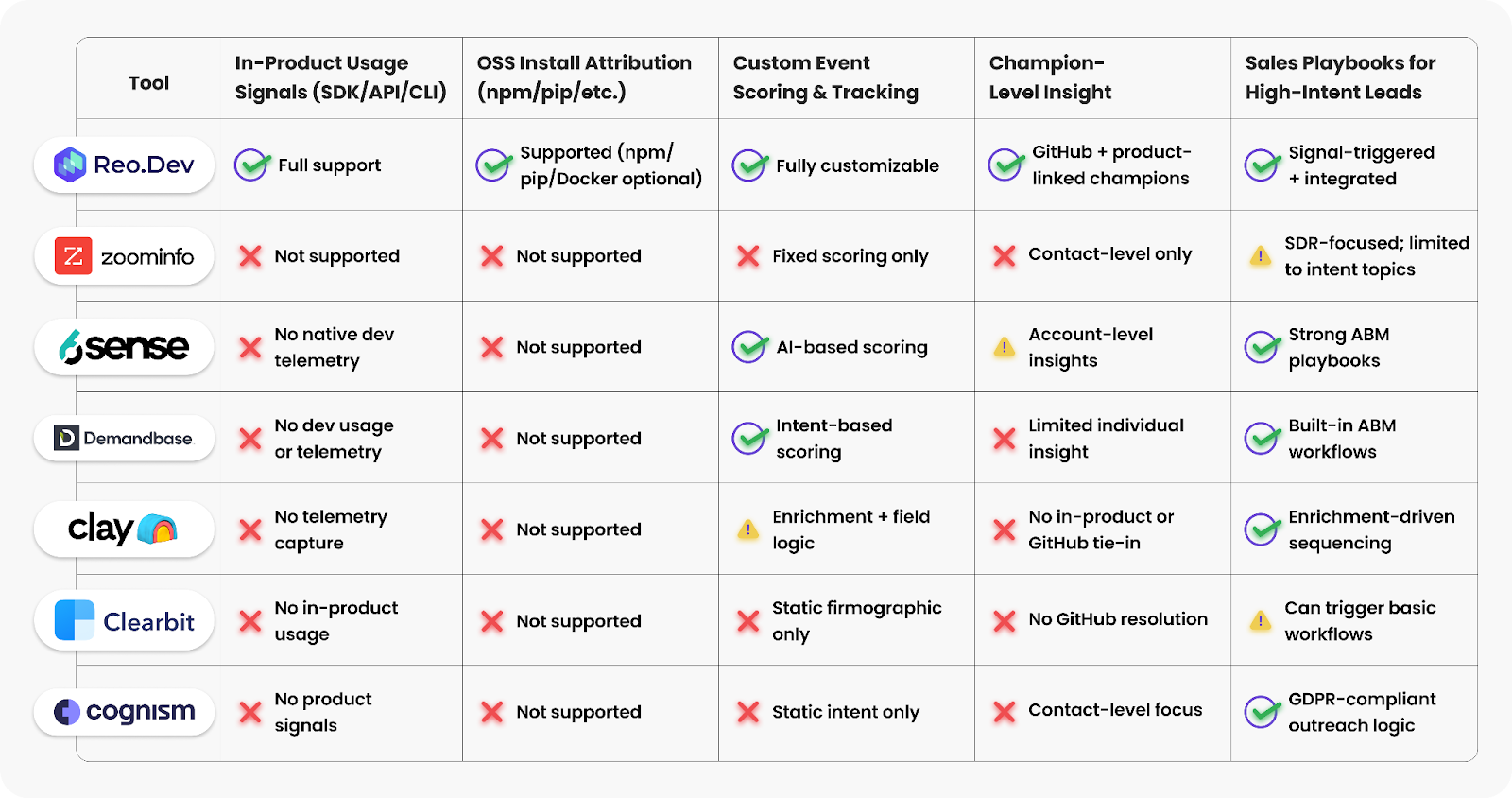
Choosing the right Koala alternative comes down to one thing: the signals that matter most to your GTM motion. Whether you need OSS install attribution, product-led usage tracking, or rich developer context - picking a platform that aligns with your funnel is key to turning intent into pipeline.

